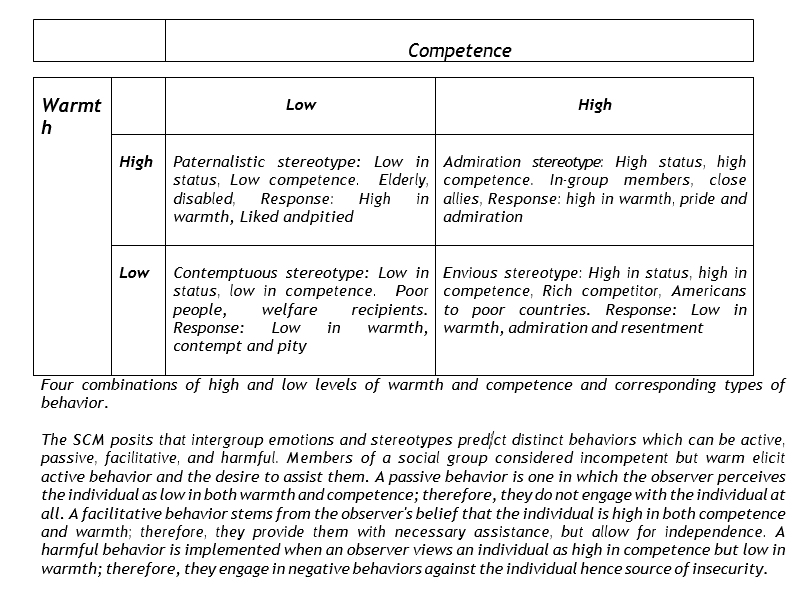It is a psychological theory that hypothesizes that stereotypes possess two dimensions: warmth and competence. Social groups are perceived as warm if they do not compete with the in group for the same resources (e.g., college space) and they are considered competent if they are high in status (e.g., economically or educationally successful). Thus, lack of competition predicts perceived warmth and status predicts perceived competence. The model was first proposed by social psychologist Susan Fiske and her colleagues Amy Cuddy, Peter Glick and Jun Xu. The theory postulates that all social groups fit within each of the four combinations of high and low levels of warmth and competence. Contradicting earlier theories of stereotype content which assumed that stereotypes reflected uni-dimensional and uniformly negative attitudes, the stereotype content model theorizes that stereotypes are often mixed or ambivalent: groups perceived to be high in one dimension, but low in the other (e.g., old people as rated high on warmth, but low on competence). The groups within each of the four combinations of high and low levels of warmth and competence elicit distinct emotions resulting to four types of stereotypes:
1. Paternalistic stereotype: Noncompetitive, low-status outgroups are perceived as warm but incompetent (e.g., housewifes, disabled and older people) and are usually liked and pitied but disrespected.
2. Admiration stereotype: Feelings of pride and admiration are aroused by groups considered both competent and warm (e.g., the in-group, close allies).
3. Contemptuous stereotype: Groups regarded as incompetent and not warm (e.g., welfare recipients, poor people) elicit feelings of contempt and pity.
4. Envious stereotype: High-status, competitive out-groups are perceived as high on competence but low on warmth (e.g., Asian, Jews, feminists, rich people) and are subject to an envious stereotype which is accompanied by feelings of admiration and resentment.
The in-group, i.e., the group to which an observer personally belongs, close allies, and societal reference groups (e.g., cultural default groups such as the middle class, heterosexuals) tend to be rated as high on both dimensions. However, there are differences between in-group perceptions between Western and Eastern cultures, with only Western cultures displaying this in-group favoritism.

Titany answered the question on
December 7, 2021 at 08:38